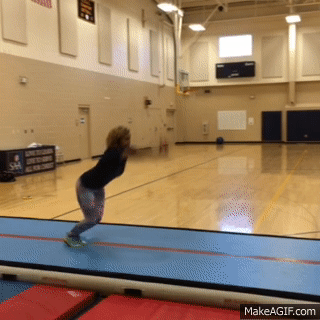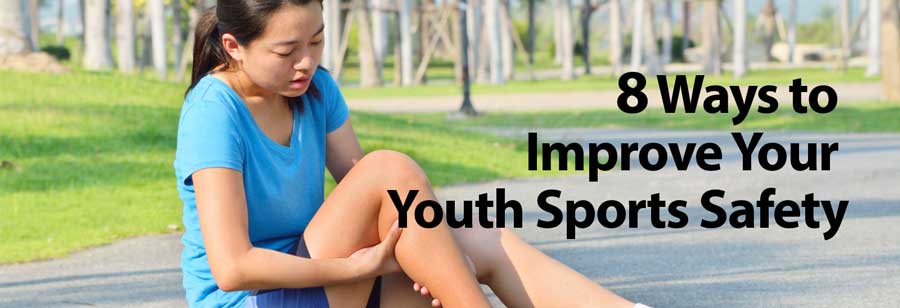I’ll never forget the first time I injured myself practicing a sport. I was in fifth grade and a member of my elementary school’s gymnastics team. Practice was almost done for the day. We were instructed to finish with some quick tumbling passes until time was up. Over the past few weeks, I had been working on a new tumbling skill called a back-handspring. I would jump back while simultaneously throwing my arms back to catch myself in a hand stand and then bring my feet around to stand up

Performing a Round-off Back handspring: Gymnast successfully completes a round-off back handspring using the proper technique and equipment.
Although I had practiced many times on a squishy mat called a “crash pad,” I had yet to perform the move on my own. But this was my moment! With bated breath I stood at the beginning of one of the mats, visualized myself performing the pass perfectly and went for it. The next thing I knew I was face down with an aching pain in my lower back.
According to STOPSportsInjuries.org, more than 3.5 million children under age 14 receive medical treatment for sports injuries each year. Children ages 5 to 14 account for nearly 40 percent of all sports-related injuries treated in hospitals. Sports injuries are a very real possibility. As risk managers, it is our responsibility to prevent them from happening and protect the injured when an accident occurs.
Having adequate supervision is crucial for all sports and activities. The number of coaches and supervising adults should be based the size of your group and the activity. These adults can help catch an incident before it turns into an injury. If an injury does occur, one coach can care for the injured, while the other adults continue to work with and supervise the rest of the group.
8 Tips to Prevent Sports Injuries
While having the right insurance coverage is important, plan to prevent injuries from happening. Here are eight tips from the Center for Disease Control and SafeKids.org to reduce sports injuries.- Ask for a physical exam. Before playing organized sports, make sure each child receives a pre-participation physical exam (PPE) by a doctor or nurse practitioner.
- Use the correct gear. Make sure each child is using the correct protective gear such as helmets, wrist guards, knee or elbow pads.
- Stay hydrated and stretch often. Encourage the children to stay well hydrated by drinking plenty of water before, during, and after play. Stretching before practice and games can release muscle tension and help prevent sports-related injuries, including muscle tears or sprains. Set aside some time every practice and game for athletes to warm up and cool down properly.
- Practice the correct way. Have children learn and practice the proper form of the skills they need in their activity. Correct form can prevent injuries.
- Take time off. Adding variety between the sports played can help prevent overused muscles and is an opportunity to become stronger and develop skills in another sport.
- Pay attention to temperature. Allow time for children to gradually adjust to hot or humid environments to prevent heat-related injuries or illness. Pay close attention to make sure players are hydrated and appropriately dressed.
- Train your coaches. Ensure all coaches are certified in first aid care, including CPR. Training can help coaches to pick up on the signs and symptoms of many injuries.
- Lead by example. Coaches should serve as a model of safe behavior by wearing the correct gear and following the rules.
What Should I Do If An Accident Occurs On Church or School Property?
If an accident occurs during a game or practice, ensure the injured child is taken care of immediately before the injury worsens, even if this means calling an ambulance.Next, you should gather everyone present at the time of the injury to record exactly what happened. You can use ARM’s Accident Investigation Form to guide you and make sure you have all the necessary information. If you receive insurance coverage from ARM, call us immediately following the incident in order to best document exactly what has happened.
Fortunately, my gymnastics injury was not serious and I recovered with only a few days of rest and prescribed stretching. Thanks to the care of my coaches and parents, I was back at practice in no time. Within a few weeks I was able to successfully (and safely) complete my back handspring. With the implementation of these tips, hopefully, your kids will be back on their feet just as quickly.
Did you know ARM provides insurance coverage for sports activities, like soccer, basketball, and gymnastics? Talk to your Account Executive today to find out more information on sports activities insurance.


